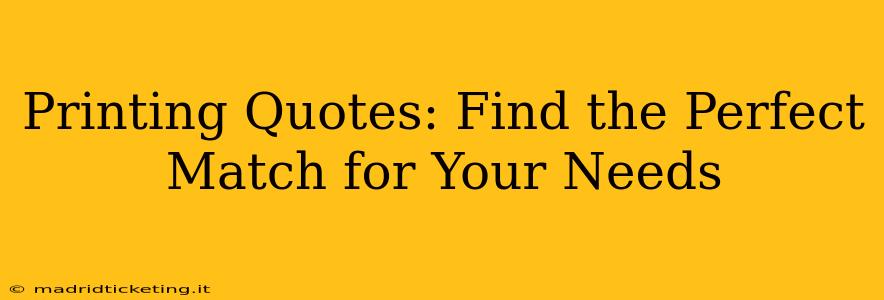Finding the right printing quote can feel like navigating a maze. With so many printers offering various services and prices, it's easy to get overwhelmed. This comprehensive guide will help you navigate the process, ensuring you get the perfect print job at the best possible price. We'll cover everything from understanding your needs to negotiating the best deal.
What Type of Printing Do You Need?
Before even thinking about quotes, define your printing needs precisely. This is the foundation of getting an accurate and relevant quote. Consider these factors:
-
Print Type: Are you looking for offset printing (large volumes, high quality), digital printing (smaller volumes, faster turnaround), screen printing (t-shirts, bags), or large format printing (banners, posters)? Each method has its pros and cons regarding cost, quality, and turnaround time.
-
Quantity: The number of prints significantly impacts the price. Larger quantities generally mean lower per-unit costs, especially with offset printing.
-
Paper Type and Weight: The choice of paper (e.g., glossy, matte, recycled) and its weight directly influence the cost. Heavier paper stock is more expensive.
-
Finishing Options: Do you need binding, cutting, folding, lamination, or other finishing touches? These add to the overall cost.
-
Color: Full-color printing is more expensive than black and white.
-
Design: Do you already have a design ready, or will you need design services from the printer? Design costs can vary greatly.
How to Get Accurate Printing Quotes
Getting accurate quotes requires clear communication. Provide the printer with as much detail as possible upfront:
-
Detailed Specifications: Include the exact quantity, paper type, dimensions, color requirements, and any finishing options.
-
File Format: Specify the file format of your design (e.g., PDF, AI, PSD). Ensuring compatibility upfront saves time and potential issues.
-
Timeline: Communicate your deadline clearly. Rush jobs often incur extra charges.
-
Request Multiple Quotes: Don't settle for just one quote. Get quotes from at least three different printers to compare prices and services.
-
Clarify All Costs: Make sure the quote includes all costs – printing, design (if applicable), materials, and finishing. Ask about any hidden fees.
What Factors Influence Printing Costs?
Several factors contribute to the final price of your printing project:
-
Printing Method: As mentioned, offset printing is generally cheaper for large volumes, while digital printing is more suitable for smaller runs.
-
Quantity: The economies of scale apply to printing. Larger orders usually mean lower per-unit costs.
-
Paper Stock: Higher-quality paper and heavier weights increase costs.
-
Finishing: Additional finishing options, such as binding and lamination, add to the overall price.
-
Complexity: Intricate designs or special color requirements might increase printing costs.
-
Rush Orders: Faster turnaround times typically result in higher prices.
What are the Different Types of Printing?
Offset Printing: Best for large print runs, offering high-quality results at a lower cost per unit.
Digital Printing: Ideal for smaller print runs, offering quick turnaround times and flexibility with design changes.
Screen Printing: Suitable for printing on textiles and other materials.
Large Format Printing: Used for producing large-scale prints like posters and banners.
How Much Does Printing Usually Cost?
This is a tricky question! The cost varies dramatically depending on the factors mentioned above. A simple black and white flyer might cost a few cents per unit, while a high-quality, full-color brochure could cost several dollars per unit. The best way to determine the cost is to get quotes from different printers with your specific requirements.
How Can I Negotiate a Better Price?
-
Negotiate volume discounts: If you're ordering a large quantity, see if you can negotiate a lower price per unit.
-
Shop around: Comparing quotes from different printers is crucial for getting the best deal.
-
Be flexible with your timeline: If you're not in a rush, you may be able to negotiate a lower price by allowing for a longer turnaround time.
-
Consider alternative options: Explore different paper types or finishing options to see if you can reduce costs without compromising quality too much.
By following these steps and understanding the various factors that influence printing costs, you can effectively navigate the process of obtaining quotes and securing the perfect print job for your needs. Remember, clear communication and thorough research are key to getting the best possible results.

